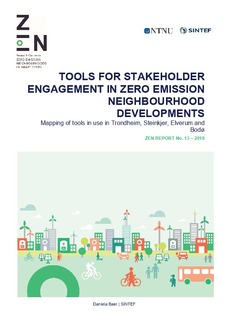| dc.description.abstract | People play a key role in zero emission neighbourhoods. They are the ones designing and creating the neighbourhood, transforming and building it and finally using it when living and working there. People play different roles in that process – such as project owners, architects, construction workers, neighbours, and users. We summarize them under the word of stakeholders. They all have a stake in the project of ZEN even if their role and influence is different and changing under the development.
Important is the way stakeholders are collaborating and how their knowledge, needs, and goals are negotiated and integrated in the project development. When asked for challenges to develop ZEN, interview partners emphasized the need for good collaboration between stakeholders. This is especially important as ZEN developments asks for more than standard neighbourhood developments: greenhouse gas emissions are an important planning and design factor, something that is new for many stakeholders, and tools and knowledge are missing for that.
This memo will present tools in use for stakeholder engagement in the four ZEN pilot projects in Trondheim, Elverum, Steinkjer, and Sluppen. The mapping of tools was conducted in 2017 and 2018, and the analysis is based on qualitative interviews with involved stakeholders in the four pilot projects.
The results show that the pilot projects use several tools on different spatial levels (city, neighbourhood and building level), and different tools are in use in different phases of development. The tools have different goals and involve different stakeholders, some are focusing on citizens, while others aim for engagement of professional stakeholders such as construction and energy companies.
The concept of the ZEN toolbox is also introduced in this memo as the tools identified in the pilot projects are to be integrated in the further development of the toolbox. But before that, we need a better understanding of the applicability and benefit of the tools used for stakeholder engagement. | |
